
The Curtiss P-40 Warhawk is an American single-engined, single-seat, all-metal fighter-bomber that first flew in 1938. The P-40 design was a modification of the previous Curtiss P-36 Hawk which reduced development time and enabled a rapid entry into production and operational service. The Warhawk was used by most Allied powers during World War II, and remained in frontline service until the end of the war. It was the third most-produced American fighter of World War II, after the North American P-51 Mustang and Republic P-47 Thunderbolt; by November 1944, when production of the P-40 ceased, 13,738 had been built, all at Curtiss-Wright Corporation's main production facilities in Buffalo, New York.

Claire Lee Chennault was an American military aviator best known for his leadership of the "Flying Tigers" and the Chinese Nationalist Air Force in World War II.

The First American Volunteer Group (AVG) of the Republic of China Air Force, nicknamed the Flying Tigers, was formed to help oppose the Japanese invasion of China. Operating in 1941–1942, it was composed of pilots from the United States Army Air Corps (USAAC), Navy (USN), and Marine Corps (USMC), and was commanded by Claire Lee Chennault. Their Curtiss P-40B Warhawk aircraft, marked with Chinese colors, flew under American control. Recruited under President Franklin Roosevelt's authority before Pearl Harbor, their mission was to bomb Japan and defend the Republic of China, but many delays meant the AVG first flew in combat after the US and Japan declared war.

The Fourteenth Air Force was a numbered air force of the United States Air Force Space Command (AFSPC). It was headquartered at Vandenberg Air Force Base, California.
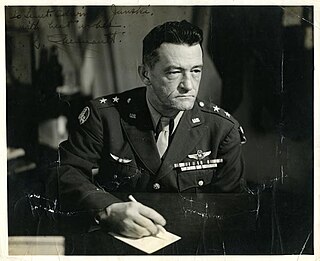
The American Volunteer Groups were volunteer air units organized by the United States government to aid the Nationalist government of China against Japan in the Second Sino-Japanese War. The only unit to actually see combat was the 1st AVG, popularly known as the Flying Tigers.

David Lee "Tex" Hill was an American fighter pilot and triple flying ace. He is credited with 12+1⁄4 victories as a squadron leader with the Flying Tigers and another six as an officer in the United States Army Air Corps in World War II. He retired as a brigadier general.
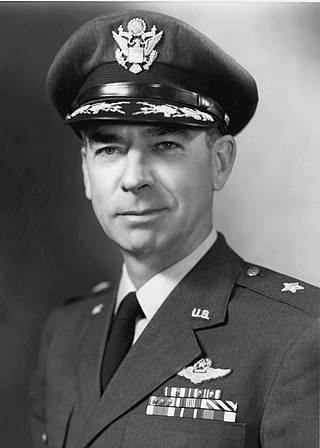
Robert Lee Scott Jr. was a brigadier general in the United States Air Force and a flying ace of World War II, credited with shooting down 13 Japanese aircraft.

Flying Leathernecks is a 1951 American Technicolor action war film directed by Nicholas Ray, produced by Edmund Grainger, and starring John Wayne and Robert Ryan. The movie details the exploits and personal battles of United States Marine Corps aviators during World War II. Marines have long had the nickname "leatherneck", hence the title.
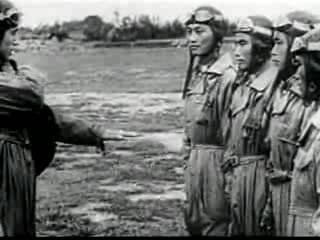
The Second Sino-Japanese War began on 7 July 1937 with the Marco Polo Bridge incident in the Republic of China and is often regarded as the start of World War II as full-scale warfare erupted with the Battle of Shanghai, and ending when the Empire of Japan surrendered to the Allies in August 1945. The Chinese Air Force faced the Imperial Japanese Army and Navy Air Forces and engaged them in many aerial interceptions, including the interception of massed terror-bombing strikes on civilian targets, attacking on each other's ground forces and military assets in all manners of air interdiction and close air support; these battles in the Chinese skies were the largest air battles fought since World War I, and featured the first-ever extensive and prolonged deployment of aircraft carrier fleets launching preemptive strikes in support of expeditionary and occupation forces, and demonstrated the technological shift from the latest biplane fighter designs to the modern monoplane fighter designs on both sides of the conflict.

Air Force is a 1943 American World War II aviation film directed by Howard Hawks and starring John Garfield, John Ridgely, Gig Young, Arthur Kennedy, and Harry Carey. The film was distributed by Warner Bros. and produced by Hal B. Wallis and Jack L. Warner. It contains incidents of supposed fifth-column activities by Japanese Americans that never happened. Conceived by then - Lieutenant General “Hap” Arnold in the aftermath of the Pearl Harbor attack, it was originally scheduled for release on December 7, 1942, on the first anniversary. It became impossible to meet that deadline, and it premiered in New York City on February 3, 1943 and was released on March 20. The film's storyline revolves around an actual event that occurred on December 7, 1941. An aircrew ferries an unarmed 1940 series Boeing B-17D Flying Fortress heavy bomber, named the Mary-Ann, across the Pacific to the United States Army Air Forces base at Hickam Field. They fly right into the middle of the Japanese air attack on Pearl Harbor and the beginning of America's major involvement in the Second World War. An uncredited William Faulkner wrote the emotional deathbed scene for Ridgely, who played the commander and pilot of the Mary-Ann.

A Guy Named Joe is a 1943 American supernatural romantic drama film directed by Victor Fleming. The film was produced by Everett Riskin and stars Spencer Tracy, Irene Dunne and Van Johnson. The screenplay, written by Dalton Trumbo and Frederick Hazlitt Brennan, was adapted from a story by Chandler Sprague and David Boehm, for which they were nominated for an Academy Award for Best Writing, Original Story.

Flying Tigers is a 1942 American black-and-white war film drama from Republic Pictures that was produced by Edmund Grainger, directed by David Miller, and stars John Wayne, John Carroll, and Anna Lee.

Fighter Squadron is a 1948 American World War II aviation war film in Technicolor from Warner Bros., produced by Seton I. Miller, directed by Raoul Walsh, that stars Edmond O'Brien, Robert Stack, and John Rodney.

Robert Tharp (R.T.) Smith was an American World War II fighter pilot and ace, credited with 8.7, 8.9 or 9 Japanese aircraft while fighting with the American Volunteer Group.
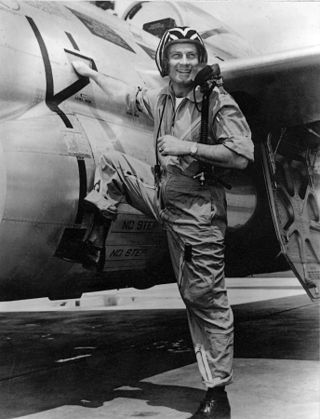
Clinton Dermott "Casey" Vincent was an American flying ace who became the second youngest general officer in United States Army Air Forces history. Vincent was one of Claire Chennault's two top fighter commanders in the China Burma India Theater of World War II. He served as the model for two comic strip characters by Milton Caniff: "Colonel Vince Casey", and "Brigadier General P.G. 'Shanty' Town".
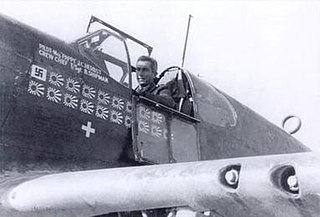
John C. "Pappy" Herbst was an American flying ace of World War II who was officially the second highest-scoring fighter pilot in the China Burma India Theater with 18 confirmed victories scored during 7 months with the 23d Fighter Group. The group commander, David Lee "Tex" Hill, called Herbst "one of the greatest fighter pilots I ever saw."
Robert William Prescott was an American aviator and entrepreneur. An ace with the Flying Tigers in the early part of World War II, he went on to found the Flying Tiger Line, the first scheduled cargo airline in the United States.

Wings Over the Pacific is a 60-minute 1943 drama film, directed by Phil Rosen and starring Inez Cooper, Edward Norris and Montagu Love. Produced by Monogram Pictures, the film depicts an island community in the South Pacific caught up in World War II.

William Norman Reed was a World War II fighter pilot, first with the Flying Tigers, then with the Chinese-American Composite Wing, Fourteenth Air Force, United States Army Air Forces. He is credited with nine aerial victories, making him an ace.



















